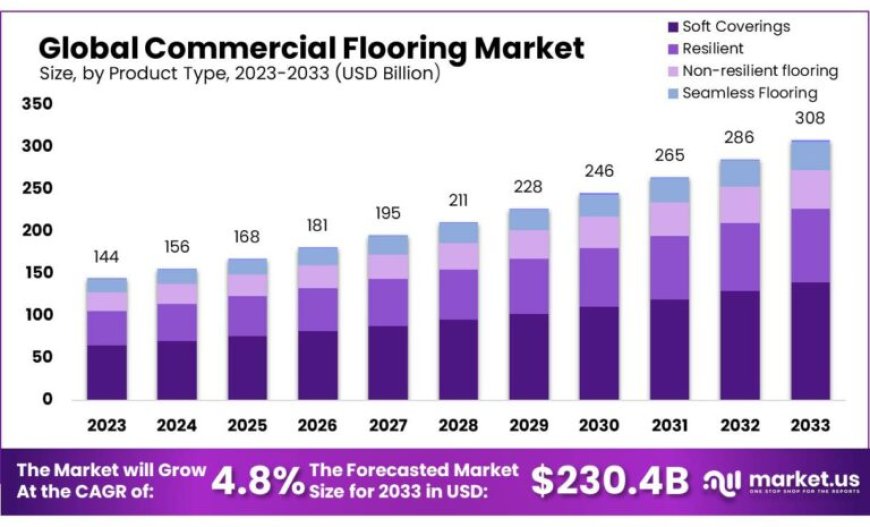Commercial Flooring Market: Innovations in Maintenance
Commercial Flooring Market size is expected to be worth around USD 308 billion by 2033, from USD 144 billion in 2023, growing at a CAGR of 4.8% during the forecast period from 2023 to 2033. Download a sample report in MINUTES@https://market.us/report/commercial-flooring-market/request-sample/

Overview
Commercial Flooring Market size is expected to be worth around USD 308 billion by 2033, from USD 144 billion in 2023, growing at a CAGR of 4.8% during the forecast period from 2023 to 2033.
The commercial flooring market encompasses all aspects related to the supply, installation, and maintenance of flooring materials specifically designed for non-residential or commercial spaces. This sector caters to a diverse range of environments, including office buildings, retail stores, hospitality venues, healthcare facilities, educational institutions, and public sector buildings. Commercial flooring products are chosen based on their ability to withstand high foot traffic, durability, ease of maintenance, aesthetic appeal, and suitability for specific functional requirements of different commercial sectors.
Key components of the commercial flooring market include a wide array of materials such as carpet, vinyl, laminate, ceramic tile, hardwood, epoxy, and rubber flooring. Each material offers distinct advantages in terms of design versatility, durability, comfort, safety features, and environmental sustainability. Manufacturers and suppliers within this market continually innovate to meet the evolving needs of commercial clients, integrating technologies that enhance performance, such as improved wear resistance, acoustic properties, and ease of installation.
Market growth is driven by several factors, including economic development, urbanization, growth in commercial construction projects, and renovation activities across various industries. Additionally, trends in interior design and corporate branding influence flooring choices, with an increasing emphasis on creating aesthetically pleasing, comfortable, and functional spaces that contribute to productivity, safety, and customer satisfaction.
Sustainability is also becoming a critical consideration, prompting the adoption of eco-friendly flooring options that meet green building certifications and contribute to reducing environmental impact throughout their lifecycle. Overall, the commercial flooring market serves as a crucial element in shaping the physical environment of commercial spaces, reflecting and supporting the functional and aesthetic preferences of businesses and institutions worldwide.
Кеу Маrkеt Ѕеgmеntѕ
By Product Type
-
Soft Coverings
-
Soft covering by application
-
Healthcare
-
Education
-
Leisure & Hospitality
-
Retail
-
Commercial Buildings
-
Public Buildings
-
Resilient
-
Resilient by application
-
Healthcare
-
Education
-
Leisure & Hospitality
-
Retail
-
Commercial Buildings
-
Public Buildings
-
Non-resilient flooring
-
Non-resilient by application
-
Healthcare
-
Education
-
Leisure & Hospitality
-
Retail
-
Commercial Buildings
-
Public Buildings
-
Seamless Flooring
-
Seamless by application
-
Healthcare
-
Education
-
Leisure & Hospitality
-
Retail
-
Commercial Buildings
-
Public Buildings
-
Wood & Laminates
-
Wood & laminates by application
-
Healthcare
-
Education
-
Leisure & Hospitality
-
Retail
-
Commercial Buildings
-
Public Buildings
By Application
-
Healthcare
-
Education
-
Leisure & Hospitality
-
Retail
-
Commercial Buildings
-
Public Buildings
Download a sample report in MINUTES@https://market.us/report/commercial-flooring-market/request-sample/
In 2023, Soft Coverings dominated the commercial flooring market with a commanding 46.9% share. These versatile and attractive floorings found extensive use in hospitals, schools, hotels, shops, and various buildings, prized for their soundproofing qualities and flexibility.
Simultaneously, the Commercial Buildings segment held a substantial 25.7% market share. This category includes office buildings, business areas, and workspaces, where durability and aesthetics are paramount for creating a professional and lasting impression.
Drivers: The demand for durable and aesthetically pleasing flooring is increasing with the construction of new offices, shops, and hotels, boosting growth in the commercial flooring market. Businesses are prioritizing unique floor designs to align with their brand identities, spurring innovation in the industry. Additionally, the adoption of eco-friendly materials like bamboo and recycled products is expanding, driven by both environmental concerns and market demand.
Restraints: Cost remains a significant barrier in the commercial flooring market, with premium materials often inaccessible to businesses with tighter budgets. Complex installation requirements for certain flooring types also pose challenges, potentially causing disruptions and increased labor costs. Moreover, the maintenance demands of some flooring options add to operational expenses, discouraging widespread adoption.
Opportunities: Technological advancements are creating opportunities for smart and interactive flooring solutions equipped with sensors, meeting the evolving needs of modern businesses. The growing preference for eco-friendly materials presents another avenue for market expansion, with increased demand for sustainable options like recycled materials and bamboo. Customization and design trends offer manufacturers opportunities to cater to businesses seeking unique and branded flooring solutions.
Challenges: The primary challenge lies in balancing cost constraints with the desire for advanced flooring materials, which can be prohibitively expensive for some businesses. Keeping pace with rapid technological changes requires continual investment and innovation, posing challenges for manufacturers. Additionally, sourcing environmentally friendly materials and managing complex installation and maintenance requirements present logistical hurdles that may limit adoption of certain flooring solutions.












